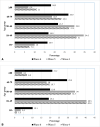Characteristics, outcome, duration of hospitalization, and cycle threshold of patients with COVID-19 referred to four hospitals in Babol City: a multicenter retrospective observational study on the fourth, fifth, and sixth waves
- PMID: 38184533
- PMCID: PMC10771668
- DOI: 10.1186/s12879-023-08939-w
Characteristics, outcome, duration of hospitalization, and cycle threshold of patients with COVID-19 referred to four hospitals in Babol City: a multicenter retrospective observational study on the fourth, fifth, and sixth waves
Abstract
Background: The aim of the present study was to compare the epidemiological patterns of severe acute respiratory syndrome coronavirus 2 (SARS-CoV2) infections, hospitalizations, deaths, and duration of hospitalization during the fourth, fifth and sixth epidemic waves of coronavirus disease 2019 (COVID-19) in Iran.
Methods: A multicenter retrospective observational study was conducted on hospitalized patients in four hospitals in the Babol district of northern Iran. The study periods were during the fourth, fifth, and sixth waves of the epidemic in Iran, (March 2021 to March 2022). A total of 13,312 patients with suspected COVID-19 were included. Patient demographics, medical history, length of hospital stay, and clinical outcomes were obtained from the hospital information system. Data on the cycle threshold (Ct) and SARS-CoV2 variant were collected for SARS-CoV2-positive cases.
Results: The highest number of hospitalized patients was reported during the fifth (Delta) wave (5231; 39.3%), while the lowest number of hospitalized patients was reported during the sixth (Omicron) wave (2143; 16.1%). In total, 6459 (48.5%) out of 13,312 hospitalized patients with suspected COVID-19 had a positive rRT-PCR result. The fifth (Delta) wave had the highest number of SARS-CoV2 rRT-PCR-positive hospitalized patients (3573, 55.3%), while the sixth (Omicron) wave had the lowest number (835, 12.9%). Moreover, 238 (3.7%) patients with laboratory-confirmed COVID-19 died. The hospital mortality rate was 6.8% in the fourth (Alpha) wave, which reduced to 2.7 and 3.5% in the fifth (Delta) and sixth (Omicron) waves, respectively (p < 0.001).
Conclusions: This is the most comprehensive study evaluating the epidemiologic characteristics of laboratory-confirmed SARS-CoV2 cases in Iran during the Alpha, Delta, and Omicron waves. The highest number of SARS-CoV2-positive hospitalized patients was in the fifth wave of COVID-19 (dominance of the Delta variant), while the sixth wave (dominance of the Omicron variant) had the lowest number. Comorbidities were similar, and cardiovascular disease, diabetes, kidney disease, and hypertension were the main risk factors in all waves.
Keywords: Alpha variant; COVID-19; Death; Delta variant; Hospitalization; Omicron variant; SARS-CoV-2.
© 2024. The Author(s).
Conflict of interest statement
The authors declare no competing interests.
Figures
Similar articles
-
Demographics, clinical characteristics, and outcomes in hospitalized patients during six waves of COVID‑19 in Northern Iran: a large cohort study.Sci Rep. 2023 Dec 18;13(1):22527. doi: 10.1038/s41598-023-50139-8. Sci Rep. 2023. PMID: 38110656 Free PMC article.
-
Demographic and clinical characteristics of hospitalized children with suspected and laboratory-confirmed COVID-19 during the six waves of SARS-CoV-2 infection in northern Iran a retrospective cohort study.Front Pediatr. 2024 Dec 5;12:1288448. doi: 10.3389/fped.2024.1288448. eCollection 2024. Front Pediatr. 2024. PMID: 39703949 Free PMC article.
-
Clinical severity of COVID-19 in patients admitted to hospital during the omicron wave in South Africa: a retrospective observational study.Lancet Glob Health. 2022 Jul;10(7):e961-e969. doi: 10.1016/S2214-109X(22)00114-0. Epub 2022 May 18. Lancet Glob Health. 2022. PMID: 35597249 Free PMC article.
-
[Effect of the Omicron variant on cumulative incidence of infection and lethality during the sixth wave of the COVID-19 epidemic in Spain].Semergen. 2024 Mar;50(2):102073. doi: 10.1016/j.semerg.2023.102073. Epub 2023 Oct 13. Semergen. 2024. PMID: 37839336 Review. Spanish.
-
Omicron variant in COVID-19 current pandemic: a reason for apprehension.Horm Mol Biol Clin Investig. 2022 Sep 5;44(1):89-96. doi: 10.1515/hmbci-2022-0010. eCollection 2023 Mar 1. Horm Mol Biol Clin Investig. 2022. PMID: 36064193 Review.
Cited by
-
SARS-CoV-2 ORF7 subgenomic RNA and Host IFN-β Expression in COVID-19 Hospitalized Patients with Different Prognosis.Int J Mol Cell Med. 2025 Jul 1;14(2):726-735. doi: 10.22088/IJMCM.BUMS.14.2.726. eCollection 2025. Int J Mol Cell Med. 2025. PMID: 40765759 Free PMC article.
-
Dissecting Sex-Specific Pathology in K18-hACE2 Transgenic Mice Infected With Different SARS-CoV-2 Variants.J Med Virol. 2025 Jul;97(7):e70506. doi: 10.1002/jmv.70506. J Med Virol. 2025. PMID: 40686017 Free PMC article.
-
Latent class analysis of hospitalization, ICU admission, and mortality among COVID-19 patients in Iran.Sci Rep. 2024 Oct 28;14(1):25770. doi: 10.1038/s41598-024-75712-7. Sci Rep. 2024. PMID: 39468177 Free PMC article.
-
Application of a self-made liver suspension device in 3D laparoscopic non-anatomical resection of liver segment VI and VII tumors.Am J Transl Res. 2025 May 15;17(5):3862-3874. doi: 10.62347/FEMB3665. eCollection 2025. Am J Transl Res. 2025. PMID: 40535623 Free PMC article.
-
COVID-19 in three waves in a tertiary referral hospital in Belgium: a comparison of patient characteristics, management, and outcome.Virol J. 2024 May 30;21(1):119. doi: 10.1186/s12985-024-02360-8. Virol J. 2024. PMID: 38816850 Free PMC article.
References
-
- Sifuentes-Rodríguez E, Palacios-Reyes D. COVID-19: the outbreak caused by a new coronavirus. Bol Med Hosp Infant Mex. 2020;77:47–53. - PubMed
Publication types
MeSH terms
Substances
Supplementary concepts
LinkOut - more resources
Full Text Sources
Medical
Miscellaneous



